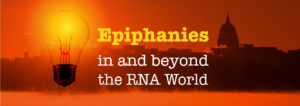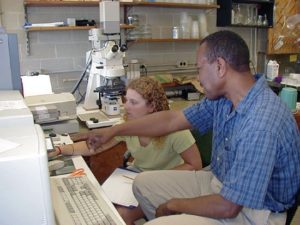
At the 2018 40th Steenbock Symposium at University of Wisconsin-Madison, twenty-seven researchers from RNA and related fields convened at the Wisconsin Institute for Discovery to share “eureka” moments in their careers. It was so inspiring to hear from founding members of the RNA community, including Joan Steitz, Christine Guthrie, John Abelson, and Harry Noller. I noticed a recurring theme throughout the talks: many of these epiphanies resulted from informal meetings (quite often at a bar or social event) between colleagues in different groups, sometimes from different universities. They discussed tough problems and brainstormed about how to solve them, pondered about what their peculiar results could mean biologically, or dreamed, “wouldn’t it be cool if we could <insert awesome idea here>?” and then came up with a way to do it. It sounded like a wonderful time to be a scientist! Sitting together freely sharing ideas, motivated by curiosity and the joy of doing science.
As I thought back to my research career to look for instances of such encounters, I was happy to find a few. “Philosophy” Meetings during grad school and Tea Time during my postdoc—informal social events to bring people together from different labs and departments with drinks and snacks. RNA Cluster Meetings during grad school and RNA MaxiGroup during my postdoc—events where people interested in a certain research area (in this case RNA) would gather for dinner and to hear an informal research talk. These organized events were intended to provide a forum for conversations between scientists to spark new ideas. Sometimes, I would talk to someone in a totally different field and learn something new. But I really didn’t have an epiphany about my own research. I often found myself (and others) scurrying away after the event to get back to lab work. Was I missing out on the best part of the meeting: the after-discussion?
My reflection on the Steenbock Symposium talks led me to ask a somewhat troubling question:
In today’s competitive research environment, have we missed out on crucial discoveries and technological advances because they weren’t given the right environment in which to develop?
Fortunately, many institutions recognize the importance of collaboration to further science. One stellar example is the Marine Biological Laboratory (MBL) in Woods Hole, Massachusetts. MBL was founded in 1888 and has a dual mission of research and education. Scientists from 237 institutions and 14 countries convene there to take/teach classes and perform cross-disciplinary research using the rich biodiversity in the region. These students and faculty work in a variety of fields, including neuroscience, physiology, parasitology, and computational biology, to name just a few. Promega provides support to MBL, as well as tools, technologies, and Promega scientists to assist with summer courses. My colleagues that have gone there have described a wonderful setting, rich with a feeling of camaraderie and teamwork.
To learn more about how MBL promotes an environment that encourages collaboration between scientists from a variety of fields, I spoke with Sebastien Laye, Chief Advancement Officer at MBL. He said that, by design, there are both formal and informal interactions to bring together students and faculty. Formal interactions include courses, lectures open to the whole campus, and “flash talks” where each speaker (students, post-docs, and faculty) can talk about one slide for two minutes. Informal interactions are quite common and are a product of the small-town community in Woods Hole—a reception after the Friday evening lectures, BBQs on the weekend, MBL softball tournament, beach, coffee shop, etc. The atmosphere is such that a student could go up to a Nobel Prize winner, initiate a conversation, and feel like they are taken seriously.

I asked Mr. Laye about collaborations that started from interactions at MBL, and he highlighted two examples. One of MBL’s goals is to develop novel model organisms, and three graduate students in one of the courses discovered some interesting biology in a previously unexplored organism. The course instructor encouraged them to pursue their studies, and the PIs from the students’ respective institutions were supportive of the collaboration. The students received a grant to return to MBL to continue their work, which is now being prepared for publication. The other example is best described by the researchers themselves in this video. MBL’s environment for cross-disciplinary collaboration is certainly a model for other institutions to follow.
The observation that teams of scientists are responsible for a greater portion of high-impact science as compared with decades ago1 suggests that collaboration results in important discoveries. There are practical motivations for the increase in team science. One idea is that today’s researchers are highly specialized in one or a few technical areas, so they need to collaborate with others to complete a project or to compete with other lab groups2. Another notion is that the increased competition for funding requires that teams work together to share expertise and resources in a cost-effective manner. However, I suspect that many formal collaborations began organically after an initial encounter between the researchers. The so-called “water cooler” effect describes how casual interactions between colleagues can build trust and bring out the best in them, leading to productive, innovative work3. Maybe such exchanges make you feel comfortable enough with a colleague that you tell them about your “crazy” idea and then, together, you figure out a way to make it happen.
Here’s to reaching out, brainstorming together, and being on your way to the next big discovery!
1 Wuchty S, Jones BF, Uzzi B. 2007. The Increasing Dominance of Teams in Production of Knowledge. Science 316, 1036-1039. DOI: 10.1126/science.1136099
2 Hall KL, et al. 2012. A four-phase model of transdisciplinary team-based research: goals, team processes, and strategies. TBM 2: 415-430. DOI: 10.1007/s13142-012-0167-y
3 Ybarra O et al. 2010. Friends (and Sometimes Enemies) With Cognitive Benefits: What Types of Social Interactions Boost Executive Functioning? Social Psychological and Personality Science 2, 253-261. DOI: 10.1177/1948550610386808
